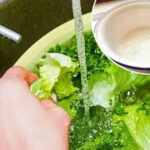Pineapple is a tropical fruit packed with vitamin C, which boosts the body’s immunity, preventing infections and aiding in treating respiratory illnesses. Pineapple is also rich in antioxidants, including flavonoids, phenolic acids, and vitamin C, which reduce the risk of chronic diseases and cancer.
Why Soak Pineapple in Salt Water Before Eating?
Many people experience discomfort when eating pineapple, such as swollen gums, acne, and a burning sensation in the mouth. These reactions are common due to the presence of bromelain, a common allergen found in this fruit. For those with sensitive constitutions, eating pineapple may even lead to symptoms like gum pain, vomiting, abdominal pain, and red rashes.
Soaking pineapple in saltwater before consumption is a popular method to mitigate these issues and offers the following benefits:
Reduced Mouth Irritation
Bromelain is a mixture of enzymes capable of breaking down proteins, which is why pineapple tenderizes meat when used in marinades. However, when consuming fresh pineapple, bromelain can cause a burning or tingling sensation in the mouth, especially for individuals with sensitive oral mucosa.
Soaking pineapple in saltwater reduces bromelain activity due to the salt’s ability to inhibit this enzyme, thereby minimizing oral irritation.

Why soak pineapple in saltwater before eating? (Illustrative image: Istock)
Reduced Sourness
Unripe pineapple tends to be sour, and this sourness can be off-putting to some, especially those with stomach sensitivities. Soaking pineapple in saltwater reduces the sourness by neutralizing the fruit’s acids, resulting in a sweeter, more palatable taste.
Removal of Impurities and Bacteria
During cultivation, harvesting, and transportation, the surface of a pineapple, especially the crevices and eyes, can accumulate dirt and various impurities. Soaking the fruit in saltwater helps eliminate bacteria and impurities, reducing the risk of bacterial infections.
How to Soak Pineapple in Salt Water
Step 1: After purchasing, peel and cut the pineapple into small, bite-sized pieces, removing the eyes.
Step 2: Prepare a bowl of saltwater with a ratio of 1 liter of water to 2 tablespoons of salt. Stir well to dissolve the salt. Submerge the pineapple pieces in the saltwater and let them soak for 10-15 minutes.
Step 3: Remove the pineapple pieces from the saltwater and serve them on a plate.
According to VTC News
The Ultimate Guide to Pineapple Prep: Beyond Peeling for a Perfectly Palatable Treat
Introducing the ultimate solution for pineapple lovers! Say goodbye to sore tongues and hello to a delicious, hassle-free experience. With just one simple step, you can enjoy pineapple like never before. Imagine indulging in the sweet, tangy fruit without any discomfort – it’s a tropical dream come true!
“The Myth of Salt Water Rinsing: A Critical Look at Vegetable Washing”
It is a common practice to soak vegetables in a diluted salt water solution, with the belief that it will eliminate bacteria and residual pesticides. However, this method is ineffective and does not achieve the desired results. So, what is the correct way to wash vegetables and ensure their safety for consumption?






































